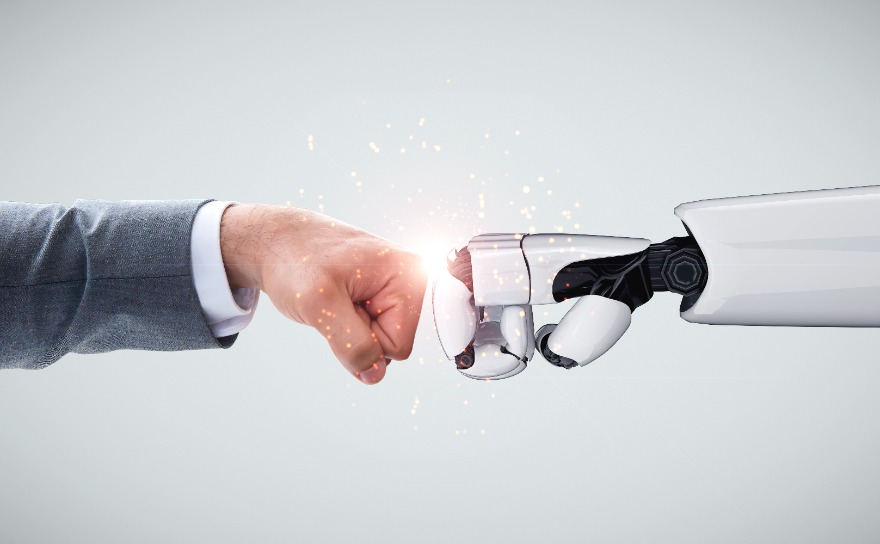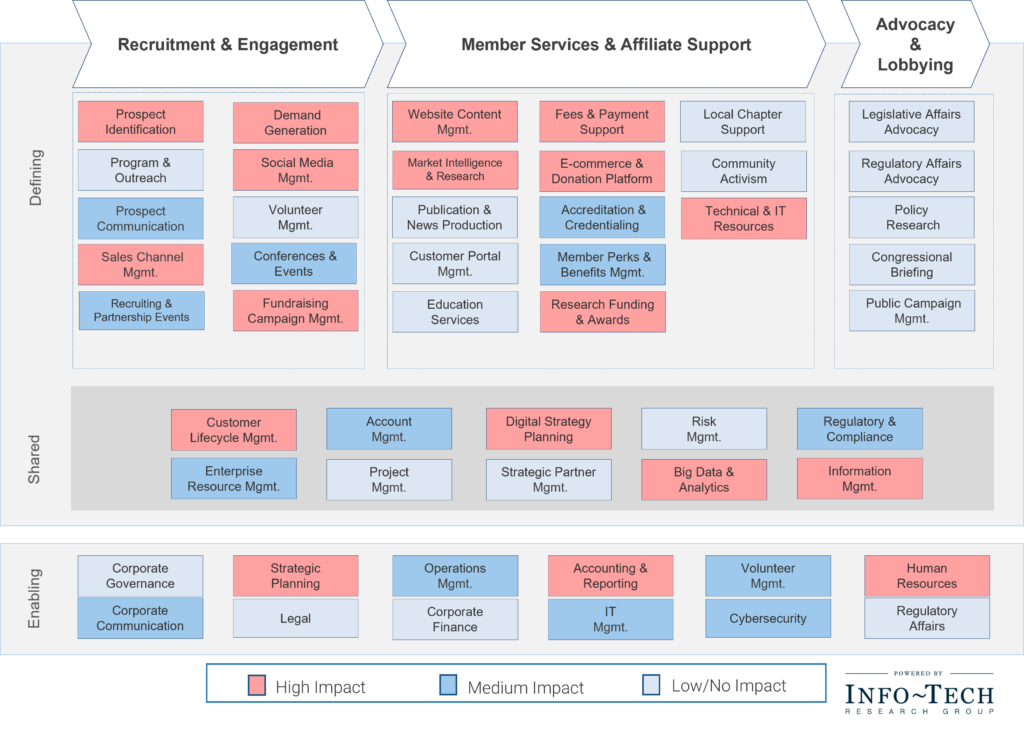Get Your Association Ready for Artificial Intelligence

The potential of Artificial Intelligence (AI) will disrupt traditional operational workflows and create new opportunities for associations. It is coming. Period.
AI is quickly developing into a go-to technology for many sectors. Associations must investigate how they could pilot or expand their use of AI tools to improve their personalized communications to members. Associations can also explore the automation of repetitive human-based activities and move them to machine-based procedures.
Our partner, InfoTech Research Group (ITRG), recently looked at how the artificial intelligence trend will impact associations and non-profits. They shared a prioritized a list of initiatives based on the impact of the artificial intelligence trend.
- AI has the potential to improve engagement with donors and members.
- AI implementations can optimize and improve internal operations.
- Change decision-making processes and adjust operational activities.
- Enable organizations to become more creative in outreach to members and donors.
- Improve core competencies and optimize external operations.
In this project, ITRG reviewed the business capability model of a typical association to show likely impact on high level capabilities of artificial intelligence.
See our related post on value stream mapping to learn how to develop a unified and validated view of key business capabilities as they align to strategic initiatives, investments, and overall strategy.
In this post, we will review those findings using our usual lens of people, process, and technology. In this case, we will look at the impact of AI on association people, impact to association process, and impact on association technology.
- Learn about artificial intelligence and how it affects both your association as a whole and IT specifically, including challenges and opportunities.
- Gauge the impact of artificial intelligence on the association specific business capabilities.
- Devise a list of initiatives you can integrate into your IT strategic plan to transform the role IT plays in your association.
Artificial Intelligence: Impact on People
Choosing a hybrid approach to AI expands the possibilities for associations and non-profits to engage with donors and members.
- As AI competencies improve over time, associations can look for areas to automate tasks that are onerous and do not build upon the skills and abilities of the organization’s support staff.
- AI offers the opportunity for organizations to automate service desk functions in IT and can move human cognitive exercises to machine-based functions. Use of chatbots in the recruitment and external service desk functions can be exploited.
- A hybrid talent model is at the heart of the future of work, and AI is going to become a supplement to the way organizations function.
- A functional adoption of AI will need to be accompanied by expertise in the areas of data science, algorithm development, system architecture and design.
- Employees with human-centered design experience will need to be nurtured into working on AI projects to develop more personalized member experiences.
- CIOs will need to consider how to leverage existing talent whose expertise resides within legacy systems.
- An attention to retraining and reskilling some employees may need to be considered so that employees meet the future needs of the organization.
Artificial Intelligence: Impact on Process
An effective AI approach will position CIOs, and IT, as value generators in associations.
- Intelligence generated from existing technology assets such as association management systems will create opportunities for associations to identify insights in real-time about how well they are reaching and engaging with members.
- CIOs and IT teams can spend less time on maintenance and more time on assisting the association with informed decision making about how they use and what they can expect from technology.
- Association CIOs will have a unique opportunity to affect the strategy of associations and can implement tactics to address key areas, including:
- Develop data assets within the association.
- Identify areas to generate further value from data assets.
- Provide strategic advice and insights into membership engagement and performance over time.
- Assist in the overall direction of the association and working in collaboration with key departments such as marketing, outreach, and learning and development.
- As AI competencies within the association evolve, there will be an expectation that members will become accustomed and satisfied with automated experiences such as chatbots, which will move existing human-focused processes to machine-based processes.
Artificial Intelligence: Impact on Technology
Think outside of the traditional IT box in experimenting with AI.
Some AI advances are not expensive or daunting to implement, and these technologies have the potential to benefit organizations in powerful ways. Most AI products and services draw on a variety of AI subsets. For example, virtual assistants and chatbots use natural language processing, speech and voice recognition, machine learning and data analytics.
- Identifying specific problems within the association that could be stood up as pilot projects to investigate the use of AI within the existing technology infrastructure.
- Professional associations could investigate experimenting with lower cost cloud-based AI software and services.
- Chatbots also have the potential to streamline routine office tasks. For example, they can be a frictionless system for scheduling meetings between two colleagues. Traditionally there are many back-and-forth e-mails in coordinating meetings is an example of how associations might soon be able to harness the power of chatbots to coordinate working group meetings.
- Privacy and security concerns about protecting personal data are a vulnerability related to pursing AI and need to be evaluated carefully.
- Risks related to the financial, tax, health, and similar records are vulnerable through some AI systems. Therefore, associations need to be concerned about what type of AI solution they implement.
The potential for artificial intelligence to improve the existing workflows in professional associations is immense. How some high-level capabilities could be affected is outlined in the image below:

Wrap Up
AI is not a magic bullet. Instead, it is a tool for speeding up data-driven decision making. A more appropriate term for current AI technology is data-enabled, automated, adaptive decision support. It is important for associations to identify AI initiatives that are reasonable to act on.
AI uses concepts and relationships from data, and in some cases learns independently from data patterns. Establishing a robust Data Governance process is the key to the success of AI projects.
Build the business case for AI around what is possible for your organization. Decide what you should be doing with AI based on what you are currently capable of doing. Focus your time on deciding which AI technologies are reasonable for your business to pursue.
Assess your current skills and identify where you will need help from vendors. AI technologies should be used to improve employee capabilities, not to replace them. Knowing when to look outside of your organization for help will be critical to your AI success.
Gain the support of the organization by showing the quick wins your AI initiative will provide and the business pains it will help to solve. Provide regular communication on the progress of your AI initiative to ensure continued support from the organization.
Artificial Intelligence is no longer the stuff of science fiction. It is a part of the fabric of daily life. Associations must understand it as a tool to improve the organization’s functionality. They must make good use of it in its current state, as well as prepare for its future use as the technology improves.



